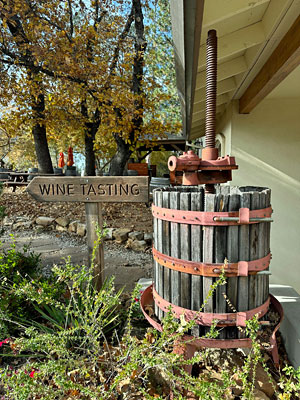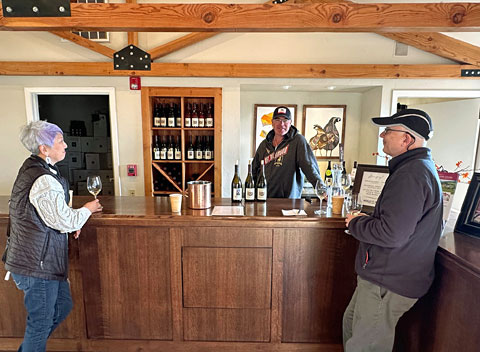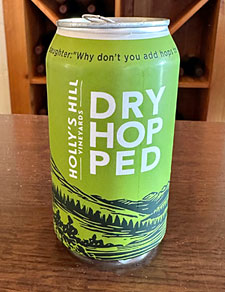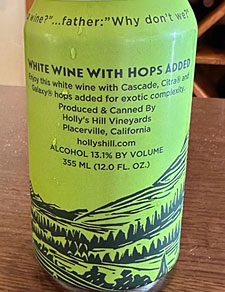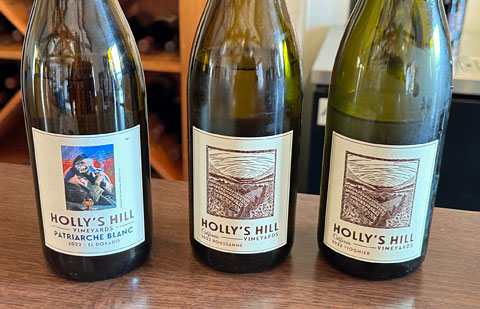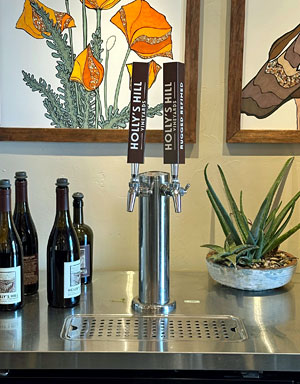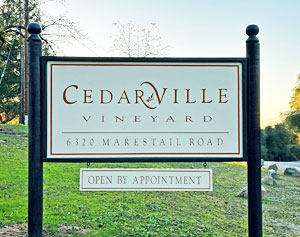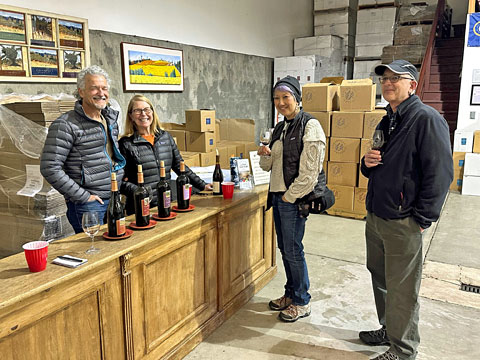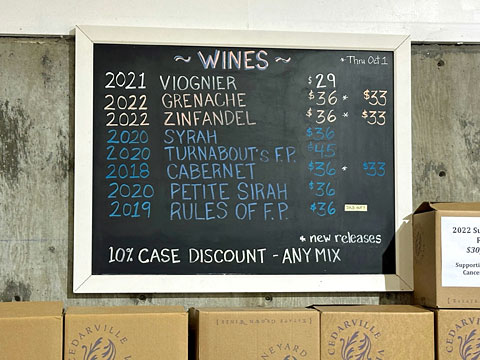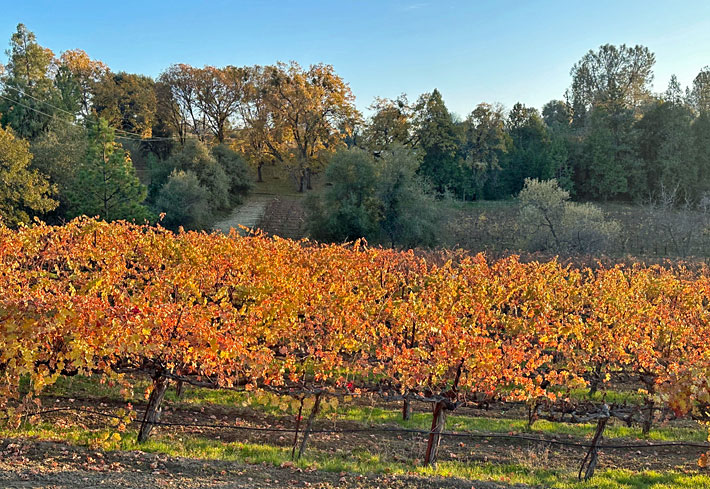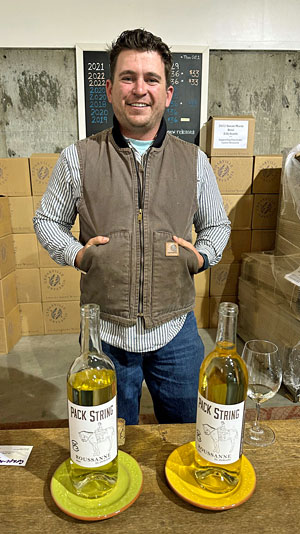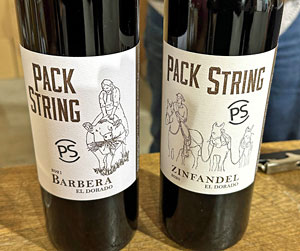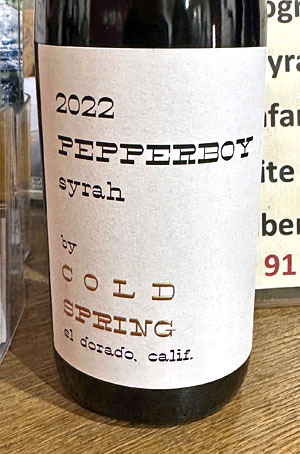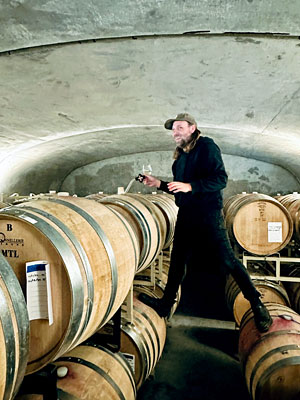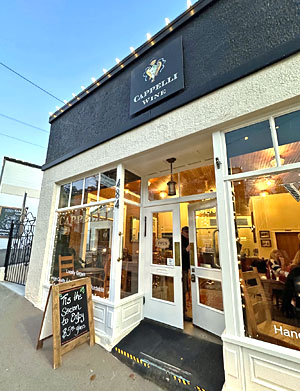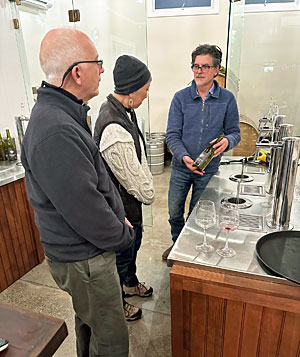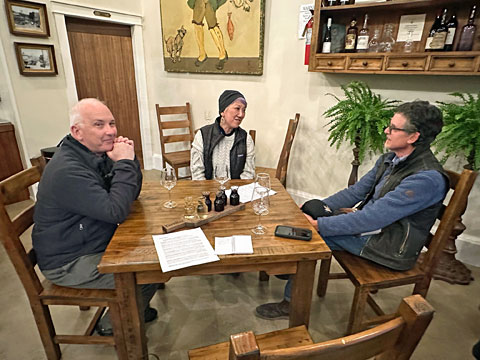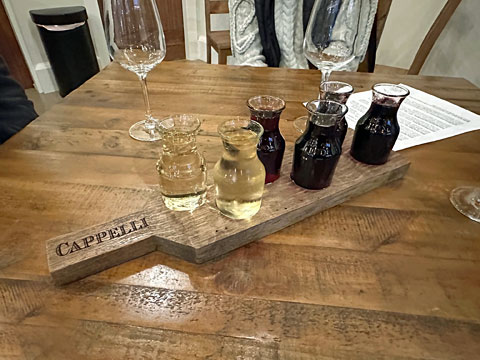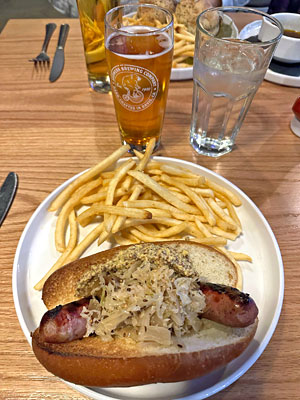Sierra Foothills Visits - November 2023
My annual fall wine trip to the Sierra Foothills has been a tradition for many years, and this year my friends Jane and Alan, who have been with me on many of these trips but haven’t come along in a number of years, were both able to join me. In choosing which wineries to visit, I picked two that we all had enjoyed in the past, since I knew they would like to revisit them. I also selected one I’d been to earlier this year since I thought it would be particularly interesting for Jane and Alan. And as it turned out, we got a couple of bonus tastings of new, up-and-coming labels at one of the wineries.
We all met up in Berkeley and I drove from there, past Sacramento, and turning off Highway 50 just short of reaching Placerville, then continuing along scenic two-lane roads to our first wine destination. The weather was fine – mostly sunny and cool but not chilly. Near the small town of Pleasant Valley, we turned onto a smaller drive and we soon arrived at our first winery of the day.
| Wednesday
- November29, 2023 |
Holly’s Hill Vineyards
We started our day with a stop at Holly’s Hill, a longtime favorite among El Dorado County wineries. Located in the Pleasant Valley area south of Placerville, Holly’s Hill focuses on wines made from Rhône-variety grapes. Since I’ve written about the winery before, I’ll give just a very brief introduction here, and more detailed information can be found in this write-up from an earlier visit, here.
Jane, Alan, and I walked from the car to the tasting room, where we were welcomed by Josh Bendick. Josh and his wife Carrie are the co-winemakers at Holly’s Hill, which Carrie’s parents Tom and Holly Cooper established in 2001. The 25-acre estate vineyard, located on hillsides topping out at an elevation of 2,700 feet, includes about a dozen grape varieties, with Mourvèdre being the most-planted variety there. Josh grew up in the San Francisco Bay Area, and after studying at UC Davis he lived in Sacramento for awhile before moving to El Dorado. He told us that his first wine job was at Winters Winery (now Berryessa Gap), and then at Boeger and Perry Creek in El Dorado County – Josh and Carrie met while they were each working for different wineries in the area.
I’ve sometimes visited Sierra Foothill wineries during the busy Thanksgiving weekend, and this being the Wednesday morning of the following week, we had the place to ourselves during our visit this time. We talked with Josh about how the 2023 growing season must have been such a relief for El Dorado County vintners after the smoke-related issues from the fall 2021 Caldor fire and a devastating spring frost in 2022. After chatting with Josh for a little while we started in with tasting many of the winery’s current offerings. We began with the 2022 “Patriarche Blanc” – the blend for this wine changes each year and this vintage is 73% Roussanne, 17% Picpoul, and 10% Grenache Blanc. With aromas of citrus, melon, fresh herbs, and a touch of spice, this had a medium-rich mouthfeel along with lively acidity and a long finish. The fruit for this wine was fermented in neutral French oak, and malolactic fermentation was blocked – as it is in nearly all of the Holly’s Hill whites – to help retain acidity and freshness.
Next was the 2022 Roussanne. Typically this comes from estate fruit but so much of the 2022 crop was lost to the spring frost that they had to supplement the smaller yield from their own vines with purchased fruit, from other vineyards in the Sierra Foothills and from Lodi. The Roussanne was barrel-fermented in neutral French oak and about 50% went through malolactic fermentation. This wine displayed apple and pear notes with floral undertones, with a more viscous texture than the “Patriarche Blanc.” The 2022 Viognier also came from purchased fruit, and like the other Holly’s Hill whites, it was barrel-fermented to give the wine more texture. As with the “Patriarche Blanc,” this one did not go through malolactic fermentation. The Viognier had brighter aromatics, with upfront floral, citrus, and peach notes characteristic of the variety, good acidity and a pleasant finish.
We continued with the NV “Dry Hopped” – this is a type of wine that I’ve only seen at one or two other places, with hops added to a white wine. Holly’s Hill now uses cans for theirs, one of a growing number of wineries packaging some of their wines in cans. The Holly’s Hill Dry Hopped wines have started out with different base wines – this one is 100% Viognier, some have been blends, and an upcoming one will have Clairette – while they’ve all had Cascade, Citra, and Galaxy hops added. Josh feels that the grape variety doesn’t impact the aromas and flavors of the wine as much as the choice of hops. In this case, the aromatics reminded me of Gewürztraminer, with bright lychee, stone fruit, and citrus notes, along with a slightly fizzy mouthfeel and crisp finish.
Moving on to red wines, we tasted the 2022 Grenache Noir. The wine was pressed early, before going dry, to help tame the variety’s tannins, and it was aged in older puncheons. Featuring bright red fruit, spice, and an herbal touch, this had a lively texture and finish.
We followed this with the 2022 Mourvèdre “Classique” – a blend of estate fruit and some purchased from the Apple Hill area just north of Placerville. This showed upfront plum and black cherry, herb, and earth aromas with a medium-light weight on the palate and fine tannins on the finish. This wine is just one of several Mourvèdre bottlings from Holly’s Hill.
Next up was one of the few Holly’s Hill wines not made from Rhône grape varieties, the 2022 Barbera. Josh told us that the fruit came from the Pilot Hill area northwest of Placerville. With bright red cherry and loads of spice on the nose, this had a bright texture and a long, flavorful finish, an elegant rendition of this variety. We finished up with the winery’s flagship wine, the 2021 “Patriarche” – in this vintage, the blend is 77% Mourvèdre, 16% Grenache Noir, 6% Syrah, and 1% Counoise. This displayed a darker fruit profile, with undertones of chocolate, smoke, and dried herbs, a bigger mouthfeel and more noticeable tannins on the finish – a few years of cellaring should be of benefit with this one.
In addition to the wines we tasted during this visit, Holly’s Hill produces quite a few other wines. These include Vermentino, Grenache Blanc, Grenache Rosé, a number of Syrah bottlings, additional Mourvèdre bottlings, Cinsaut, Counoise, Carignane, Petite Sirah, several additional red blends, and Syrah Port.
An exciting new part of the Holly’s Hill business is that they now produce beer as well as wine! Josh told us that he’d been a home brewer for awhile and that the family felt adding beer to their lineup would help to bring in more new customers. Josh makes a variety of styles, including Hefeweizen, Pilsner, IPA, Porter, and more. While we ran out of time to sample the beer there on this visit, I’ll have to be sure to do it next time I stop at Holly’s Hill! The beer is currently only available on tap at the tasting room but there are plans to sell some in cans in the future.
This was my first visit to Holly’s Hill since just before the start of the pandemic, and it was a pleasure to return and spend time tasting with Josh. As usual here, it’s not easy to pick standout wines since everything we tried was very good, but my favorites included the 2022 “Patriarche Blanc,” 2022 Viognier, 2022 Grenache Noir, 2022 Mourvèdre “Classique,” and 2022 Barbera. In addition, the NV “Dry-Hopped” deserves mention as a wine that different and fun. The wines at Holly’s Hill have shown great consistency over the years, with a fine balance of ripe fruit and lively acidity, and with very good tannin management. I also find the absence of new oak in the wines here to benefit the winery’s style. A visit to Holly’s Hill is really a no-brainer if you’re tasting wines in the Pleasant Valley region of El Dorado County.
I’d been unsure of the weather outlook for the day and figured we might be better off finding a spot to have lunch indoors rather than having an outdoor picnic. There are not a lot of dining options in the Pleasant Valley area, and curiously, I found that most of them were closed on Wednesdays. Checking online, it looked like Bones Roadhouse, just a short drive from Holly’s Hill in Pleasant Valley, would be our best choice. From the outside, it sure did look like a classic roadhouse, and there was plenty of space to park right in front. The inside had a roadhouse vibe too, with dark colors, fairly dim lighting, and a large U-shaped bar taking up much of the space. The large windows kept the space from being too dark, though. We found a table right away, but within a short time the place filled up pretty well, both at other tables and at the bar. It was clear that many of the customers knew each other, and that this was a popular spot for locals to gather, which gave it a welcoming feel.
The menu is about what you’d expect – a few fried appetizers, wings, burgers, hot dogs, and a variety of hot and cold sandwiches, along with a decent selection of beers. Our server took our order promptly, and the food came out before too long, served in a plastic basket. I had a pulled pork sandwich with fries (you can also get all sandwiches and burgers with onion rings or on their own). The sandwich was good but unremarkable, though the fries were terrific. I heard later from a couple of locals that the burgers are excellent, so if I’m back there I’ll have to try one. Overall I enjoyed Bones Roadhouse, and with so few dining options in the area, there’s a good chance I’ll be back.
Cedarville Vineyard
After lunch we turned south along Mount Aukum Road, crossing a couple of forks of the Cosumnes River before coming to the Fair Play wine region in southern El Dorado County. Our destination there was Cedarville Vineyard, another Rhône-variety specialist. I’ve been visiting Cedarville for over 20 years and writing about them for nearly as long, so rather than repeat myself too much here, I’ll just provide a brief introduction and guide you to the more detailed information in this past write-up, here.
Cedarville was established in the mid-1990s by co-winemakers Jonathan Lachs and his wife Susan Marks, who sadly passed away in 2020. The winery’s first commercial vintage was from 1998, and the winery building – partly built into a hillside for natural cooling – was completed a couple of years later. While the winery’s focus is on wines from Rhône Valley grape varieties, and they also make Zinfandel, Cabernet Sauvignon, and Petite Sirah, plus a couple of blends. Other than the Petite Sirah, all of their fruit comes from their 15-acre organically-farmed estate vineyard. In recent years they’ve cut back on production for their own label while in turn selling more of their estate fruit to a number of well-regarded vintners.
Jane, Alan, and I stepped into the winery, and Jonathan welcomed us in, along with the new Susan in his life, Susan Lund. Jonathan refers to her as “Susan Elizabeth” to distinguish her from his late wife “Susan Marie”. It’s great to see Jonathan and Susan so happy together, and Jonathan clearly appreciates Susan’s warm spirit and all she does to help out at the winery. While I’ve been to Cedarville a number of times in recent years, neither Jane nor Alan – who have each visited there many times in the past – had been there for about 5-6 years, so we all spent a little while talking with Jonathan and Susan before we began tasting.
Jonathan and Susan poured us all three of their new fall releases, and we started with the 2022 Estate Grenache. As usual, this one includes some co-fermented Syrah – 10% in this vintage. The wine undergoes lees-stirring in some of the barrels (all French oak) to increase the texture. Displaying red cherry and strawberry fruit, touches of pepper, spice, and oak, plus stony mineral undertones, and the wine had medium body and moderate tannins. The Cedarville Zinfandel has sometimes had a little Petite Sirah blended in but recent vintages have tended to be 100% varietal, and this is the case with the 2022 Estate Zinfandel. The fruit came from all of the vineyard’s Zin blocks in 2022, as there was so little fruit due to that spring’s frost. With bright berry fruit along with a brushy herbal character and vanilla notes, this had a lively mouthfeel and firm tannins that suggest that it might be worth cellaring this wine for a year or two.
The final new release wine we tasted was the 2018 Estate Cabernet Sauvignon. This is 100% varietal, and the wine was aged in 50% new French oak and 50% second fill barrels. Jonathan told us that he likes using barrels from the Seguin Moreau cooperage for the Cabernet. This wine had lots of blueberry, plum, and dried herb aromas plus touches of spice and mocha, with a fine balance of rich texture and acidity, and fine tannins on the long, flavorful finish. Jonathan noted that he was only able to make two barrels of Cabernet Sauvignon in 2022 since so much of the crop was lost to the spring frost.
Jonathan and Susan opened one more bottle for us to taste, the 2021 Frostwatch Vineyard “Susan Marie” Merlot. Jonathan has made a special “Susan Marie” bottling since 2020 in her memory – the sales of this wine help to raise funds for the Pancreatic Cancer Action Network (PanCAN). The first two “Susan Marie” wines were both an estate rosé, and this Merlot will be released in spring 2024. Jonathan had looked for 2021 fruit to purchase due to smoke issues from the nearby Caldor fire, and he was able to find this Merlot – Frostwatch owners Brett Raven and Diane Kleinecke became close friends of Jonathan and Susan back in their UC Davis days. This wine was aged in one new Seguin Moreau barrel and one older one. The wine featured lots of cherry and spice on the nose, with touches of dried herbs and pepper, a bigger mouthfeel along with lively acidity and firm tannins on the finish. Tasty already though still a youngster, this can definitely stand up to some aging.
In addition to the wines we tasted on this visit, Cedarville also makes Viognier, Syrah, Petite Sirah, as well as two red blends – “Turnabout’s Fair Play” and “Rules of Fair Play”.
This was a fun visit to Cedarville, especially since it had been quite awhile since Jane and Alan had been able to come along with me for a stop there. It was great to spend time with Jonathan and Susan – in a region that boasts many terrific winery hosts, they’re certainly among the best. Since we only tasted four wines on this occasion it’s almost impossible to pick any particular standouts – you won’t go wrong with any of them. The Cedarville Zinfandel and Grenache are consistent favorites and the Cabernet Sauvignon is unquestionably among the best you’ll find in the Sierra Foothills. And the Merlot will be well worth waiting for its spring 2024 release. I’ve mentioned both the beautiful balance and the potential for cellaring in Cedarville’s wines in the past, and these characteristics were evident in the wines we tasted with Jonathan and Susan on this visit. Cedarville is open by appointment only, and they definitely should be on your list of wineries to visit if you’re looking to taste wine in southern El Dorado County.
When I’d made an appointment with Jonathan to visit Cedarville, he asked whether my friends and I would like to taste wines from a couple of new labels there as well. Of course I couldn’t say no to that! We’d hoped to see Cedarville assistant winemaker Jill Winter and taste wines from her brand new Quartz Vein label, which she’s making there, but she was unable to join us – hope to try her wines on my next visit. We did taste wines from two other new labels, though – Pack String and Cold Spring.
Pack String Wines
It was a real bonus for Jane, Alan, and I to be able to taste wines from a couple of newer wine ventures while we were visiting Cedarville Vineyard. First up was Pack String Wines, the label of James and Danielle Frost. James has a vineyard management business called Frostwood, and currently manages about 18 vineyards with over 100 acres. He grew up in El Dorado County, and worked in vineyard management in Oregon for a time before moving back. He and Danielle launched the Pack String Wines label with the 2020 vintage, and the wines are being made at the Holly’s Hill facility in the Pleasant Valley area of El Dorado County.
James told us that the name of the label comes from a number of family members who have led a pack string of mules into the Sierra backcountry to explore and enjoy the mountains. The artwork on the labels was made by Danielle and James, and each label drawing is based on a different family photo. Fruit for the Pack String wines is entirely sourced from local El Dorado vineyards, and all of the wines are made in small lots.
James and Danielle purchased property a few years ago in the Apple Hill area just north of Placerville, and they plan to plant their own vineyard and build a winery and tasting room there. James mentioned is that part of the overall focus of the winery is to be as local as possible, to highlight the El Dorado County origins of the fruit and winemaking – and even the label design – and to help celebrate and promote what can be done locally within the county.
We tasted four Pack String wines with James, starting with the 2020 Roussanne. The fruit came from Sauber Vineyard in the Happy Valley area east of Somerset in southern El Dorado County. Showing citrus, stone fruit, and pear aromas along with fresh herbs and a touch of spice, this had a medium-rich texture that was nicely balanced by vibrant acidity, with a long and lively finish. Next was the 2021 Roussanne – this fruit was sourced from Sierra Vista Vineyard in the Pleasant Valley region. This had stone fruit and melon notes with smoke and spice undertones, medium-full body, with a bit of roughness on the finish that suggest a bit more cellaring might be of benefit.
We continued with two wines that were both sourced from Smokey Ridge Ranch in the Apple Hill area. First was the 2021 Sangiovese Rosé, which displayed bright red fruit and citrus on the nose plus a touch of stone fruit, with lively acidity and a hint of smoke on the finish. We finished up with the 2020 Zinfandel – with clove and other spices supporting ripe black cherry and plum fruit, this had a broad texture and long, tasty finish with moderate tannins.
Other currently available Pack String wines that we didn’t taste on this occasion include 2020 Sangiovese Rosé and 2021 Barbera.
It was great to taste the Pack String wines with James. The 2020 Roussanne was a real standout, and the 2020 Zinfandel was not far behind – both highly recommended. I always enjoy trying wines from newer, under-the-radar producers, and it should be worth keeping an eye on James and his Pack String label in the coming years.
Cold Spring Wine
We had one more new wine label to check out while we were at Cedarville Vineyard – Cold Spring Wine from longtime vintner Adam Smith. Adam has worked in cellar and winemaking positions for a number of years, at acclaimed wineries such as Domaine Méo Camuzet in Burgundy, Craggy Range in New Zealand, Domaine Serene, Bethel Heights, and Shea in Willamette Valley, and Banshee in the Sonoma Coast before returning to El Dorado County, where he grew up. Since coming back, he’s been the winemaker for Skinner and consulted for other Sierra Foothills labels.
Adam established his new Cold Spring label beginning with the 2022 vintage, and he’s focusing on wines from Rhône grape varieties sourced from El Dorado vineyards. We talked with him about his winemaking goals, and he told us that he wants his wines to display an El Dorado regional character while still showing terroir distinctions between individual vineyards. He knows that displaying region-wide as well as specific vineyard character in a wine is not an easy task but he feels that his work with El Dorado fruit from a number of different vineyard sites in recent years is valuable experience in achieving that goal. I asked what he thinks is a signature El Dorado character in wines, and he said that an allspice / orangepeel character in reds is a particular one that he’s noted.
We talked a little with Adam about his winemaking. He told us that he likes to pick white varieties in the range of about 20.5 to 22 brix – he feels that brings out the flavors he’s looking for while still retaining a fresh acidity. Adam favors native fermentations for his wines, and uses a percentage of whole clusters for most of his red fermentations. He lets the wines settle in tank before racking them to barrel and plans to bottle the 2023 wines prior to the 2024 harvest.
Adam wanted us to taste a number of his 2023 tank and barrel samples at Cedarville, where he’s making his Cold Spring wines. We started with a tank sample of the 2023 Wylie Vineyard “Clementine”, a blend of Grenache Blanc and Vermentino. Many will remember this vineyard, which was neglected for some years but now has new ownership and a new name, though Adam has decided to use the original name as a tribute. The six-acre vineyard was planted in the mid-1980s and is about half Grenache Blanc and Vermentino and half Syrah. The “Clementine” fruit was whole-cluster pressed, underwent a short fermentation, and was in a stainless steel tank still going through malolactic fermentation when we visited. The wine had tropical fruit aromas, nice mouthfeel with vibrant acidity and a fresh finish. We followed Adam into the barrel room – a concrete-vaulted underground space that stays naturally cool – and he had us taste his 2023 Cedarville Vineyard “Beeswing” Viognier. This featured stone fruit and tropical fruit on the nose, with a lively texture and zingy finish.
We continued with two Grenache barrel samples from different vineyards. First was the 2023 Marchini Vineyard Grenache, sourced from older vines at a site between Placerville and Coloma, and fermented with 50% whole clusters. With upfront red fruit and spice notes, this had a bright mouthfeel and fine tannins on the finish. Next up was the 2023 Starfield Vineyard Grenache – this vineyard is just north of Placerville, and about 20% of the fruit for this wine was whole-cluster fermented. This wine showed more floral aromatics along with iron, spice, and cherry, with a bigger texture and more prominent tannins than the Marchini Grenache. Each of these Grenaches showed very distinct character and both are intended to be single vineyard designates.
|
| Adam Smith - Photo credit: Jill Winter |
We continued with Syrahs from two sites, starting with the 2023 Wylie Vineyard Syrah. This was the only red barrel sample we tasted with Adam that was made entirely with destemmed fruit. Showing both red and black fruits plus spice and lively acidity on the palate, this was noticeably reductive when we tried it but that should resolve with more time in barrel. The 2023 Cedarville Vineyard Syrah was made with 20% whole clusters and was co-fermented with a little Viognier. Lighter in color than the Wylie Syrah and with more bright and slightly floral notes along with darker berry fruit, this had a great mouthfeel and moderate tannins.
Moving on to Mourvèdre, we tasted the 2023 Mais Fica Vineyard Mourvèdre, from a vineyard site in the Pleasant Valley area. This displayed what I think are classic El Dorado Mourvèdre characteristics, with plum, iron, and savory herbal notes, medium weight on the palate, and firm tannins. Our final barrel sample was the 2023 Starfield Vineyard Mourvèdre. This seemed less developed at this stage than the Mais Fica barrel sample but showed some pleasant floral aromas along with plum and darker berry fruit. Both of these Mourvèdres were fermented with 30% whole clusters, and Adam plans to blend both together.
I’m sure that Adam would have continued with more barrel tasting but we had to get back on the road for our next wine appointment, so he concluded our tasting with a bottled wine, the 2022 “Pepperboy” Syrah. With fruit sourced from a nearby vineyard, the wine includes a little Viognier and Cinsault. Adam told us that future “Pepperboy” vintages will most likely be blends, probably Syrah-Grenache-Mourvèdre-Cinsault. Featuring dark berry fruit, earth, spice, dried herb, and smoked meat aromas, this had medium-full body and firm but not harsh tannins. It’s certainly tasty already, but this wine is still a youngster and deserves some time in the cellar to show its full potential.
We had a fun time tasting Adam’s brand-new Cold Spring wines. He has a very outgoing personality and his enthusiasm was obvious as we tasted with him. Although Adam has been making wine for a number of years, Cold Spring is a new venture for him and it looks to be getting off to a very promising start based on what we tasted with him. Although it’s often tough to get a good grasp of what a wine will develop into when tasting such young tank and barrel samples, my favorites were the 2023 “Beeswing” Viognier, 2023 Marchini Vineyard Grenache, 2023 Cedarville Vineyard Syrah, and 2023 Mais Fica Vineyard Mourvèdre. In addition, the bottled 2022 “Pepperboy” Syrah was a standout. Cold Spring is definitely a new label to watch.
Cappelli Wine
Our final wine visit of the day was at Cappelli Wine in Placerville. Their tasting room right along the town’s charming main street is open daily, and I’d arranged to meet owner/winemaker Marco Cappelli there. I’d visited with Marco earlier this year and wanted to show my friends Jane and Alan the unique concept behind his winery and tasting room. To avoid too much repetition, I’ll give just provide some introductory notes here, and you can find much more detailed information in my earlier write-up, here.
Marco has had a long history in the California wine business since earning an enology degree from UC Davis in 1984, most notably as winemaker at Swanson Vineyards in Napa Valley for 17 years. He decided to move to El Dorado County in 2004, and he’s been making wine for many local labels in the years since, mostly at Miraflores Winery in the Pleasant Valley area. Marco also owned the noted Herbert Vineyard in the Fair Play region for a number of years but sold it and moved to Placerville with his wife Belinda after the 2021 Caldor Fire. The couple had already started working toward launching their new winery and opening their Placerville tasting room before then, and the tasting room opened in spring 2023.
I mentioned the interesting concept behind how the winery and tasting room are run. Marco brings in 15-gallon kegs of his wines to the tasting room for filling bottles on the spot. He uses Vinolok glass closures so that customers can bring both the bottles and closures back to the tasting room to be cleaned and re-used, getting a discount on a new bottle of wine when they do. The bottles, labels, and closures are all identical, and a small circular sticker is added to the top of the Vinolok closure to identify the wine in the bottle. Marco’s goal is to produce terroir-driven wines sourced from local vineyards at affordable prices for everyday drinking, much as the wines he’d found during a year-long stay in Italy with Belinda and their children a few years ago. He’s noted that the wine shouldn’t be the most expensive thing on the dining table, and his new system is one way to keep costs down so the wine is more affordable – and re-using the bottles and closures is good for the environment as well.
After our drive from the Fair Play area to Placerville, we parked a short distance down the street from the Cappelli tasting room and walked up to it. Jane and Alan had just walked into the tasting room and I was taking a couple of photos outside when I turned and saw Marco walking up the street – he and Belinda live only a short distance from there. We walked in, and the place was busy, even on a late Wednesday afternoon – a great sign that the new tasting room is thriving. There are typically six dry wines plus one sweet one available for tasting, and the line-up changes as the wines – which are all produced in fairly small lots – are sold out and replaced by other ones. After having a seat with Marco at one of the tables inside the bright airy space, we were brought small containers of each wine so we could taste at our own pace.
We started out with the 2022 “Bianco” – a blend of mostly Chenin Blanc along with a little Chardonnay and Vermentino. This featured bright stone fruit aromas with floral undertones, medium weight on the palate, and a pleasant finish. Next up was the 2021 Chardonnay from Calaveras County and Clarksburg. With citrus, pear, and floral notes plus just a touch of oak on the nose, the wine had medium body, fine acidity, and a crisp finish – a lighter and fresher style than many California Chardonnays. The production of this Chardonnay shows how Marco is keeping costs down to make the wines as affordable as they are. Some wine lots – such as the Clarksburg component in this case – are made from bulk juice or wine purchased from custom crush clients at the Miraflores facility, where Marco continues to consult and where he makes his own wine. Marco made the Calaveras component of this Chardonnay from fruit he purchased from a vineyard near Murphys – he barrel-fermented it using native yeast.
Moving to red wines, we tasted the 2020 Pinot Noir, sourced from the same site near Murphys in Calaveras County as the Chardonnay. This showed a bright red fruit profile with earthy undertones, a lively mouthfeel and fine tannins. We followed that with 2022 Barbera from Cooper Vineyard in Amador County’s Shenandoah Valley, one of California’s most famed vineyard sources for Barbera. This was a standout, with upfront red cherry fruit, herbs, and a touch of spice, with medium texture on the palate and a clean, vibrant finish.
The 2020 Bordeaux-Inspired Blend combines Merlot from the Murphys area and Cabernet Franc from the Fair Play region. Displaying black cherry and darker fruit, cedar, and earth on the nose, this had medium-full body with firm but not harsh tannins on the finish. Our last red wine was the 2021 Rhône-Inspired Blend – this includes Syrah and Petite Sirah from Herbert Vineyard in Fair Play plus Mourvèdre from Cooper Vineyard. This had bolder dark berry fruit aromas with spice and mocha undertones, finishing with bigger tannins.
We finished our tasting with the NV Mission Angelica, with fruit sourced from Rinaldi (formerly Eschen) Vineyard in the Fiddletown region – the Mission vines there may be over 150 years old. Marco is acknowledged as the foremost producer of Angelica – this sweet fortified wine made from Mission grapes was probably California’s earliest signature wine style though few vintners produce it these days. Marco ages his Angelica wines for quite awhile – this one, made from multiple vintages, has had an average of eight years in barrel. The wine is intentionally allowed to oxidize in barrel, giving it a character not unlike a Tawny Port. With aromas of caramel, stone fruit, and nuts plus earthy undertones, this had a rich texture with a very long, sweet finish. This type of wine won’t be for everyone but it’s a first-rate example of what Angelica can be.
In addition to the wines we tasted with Marco, there were also bottles of 2021 Cabernet Franc available at the tasting room. This wine is 100% Cab Franc, and unlike the other Cappelli wines, this one is bottled with a traditional cork closure so it can be cellared for awhile.
I mentioned how affordable the Cappelli wines are, with current ones ranging from just $12-$18 per bottle (more for the Angelica) and with an added discount for returning an empty bottle. Due to hand-bottling each wine from kegs, Marco recommends drinking them within a few months so they will retain their freshness. Bottling the wines this way means that they’re generally available only through the tasting room in Placerville, though a few local restaurants serve it from keg as well. After we’d finished tasting with Marco, he told us that he’s enjoyed his current foray into the retail sales and tasting room side of wine production, though he’s thinking of taking a larger role again in the grape-growing and winemaking side of it, and he may eventually look to plant a new vineyard and build his own winery.
This was another fun visit with Marco at the Cappelli tasting room, and I was glad that Jane and Alan could learn about the unique things he’s doing there. Quite a few other people tasting there stopped to say hello to him so it was clear that he’s there regularly and really connects with his customers. As I found in my previous visit, the new Cappelli wines deliver a lot more for the money than nearly any other California wines you’ll find in this modest price range. My favorites on this occasion were the 2022 “Bianco,” 2022 Barbera, 2020 Bordeaux-Inspired Blend, and of course the NV Mission Angelica. If you’re in the Placerville area, don’t miss stopping in at the Cappelli tasting room.
After leaving Cappelli, Alan, Jane, and I discussed dinner options. Though we’ve often had dinner in the Placerville area at the end of our Sierra Foothill wine trips, we decided this time to cut the length of the after-dinner drive and find a place to eat in Sacramento or Davis. Alan suggested Sudwerk, a brewpub in Davis. We’d both been there a number of years ago but it had been closed for some time – even before the pandemic – and Alan had been glad to find online that it was now open again. It originally specialized in German-style food, but we could see from their online menu that it now offered more basic brewpub food with just a couple of nods toward their past German food options.
Sudwerk is a fairly large place that features a big sheltered patio with heaters along with plenty of indoor seating. We were seated right away, and the service was quick and professional if not especially friendly. I ordered the main throwback option to the restaurant’s old days, the Pilsner Beer Brat with house sauerkraut, hefeweizen onions, whole-grain mustard on a brioche bun, which came with fries. There's an extensive choice of Sudwerk beer on tap, and I had the Festbier Oktoberfest Lager. There's also a small selection of wine and spirits available. My food was tasty, though the bun fell apart halfway through eating my brat, so I had to use a knife and fork to finish it up. There was a trivia night going on in the patio and the speaker’s questions were blaring pretty loudly indoors on the restaurant speakers for much of our meal, which was alternately intriguing and annoying. Overall Sudwerk was fine for what it was though sadly it's almost completely lost the charming character of its earlier incarnation.
I keep coming back to the Sierra Foothills for wine tasting for many reasons. It’s a particularly scenic area (especially in late autumn), many of the vintners I’ve met there are among the friendliest I’ve encountered, and the wines from this region are frequently a bargain compared with other California wines of similar quality. As mentioned at the beginning of this write-up, the wineries and tasting rooms that Jane, Alan, and I visited were ones I’d been to in the past, but they all offer some of the best experiences I know of in the El Dorado wine region. Holly’s Hill and Cedarville have been longtime favorites, while Cappelli presents something new and different from a highly-regarded vintner. And it was great to have the opportunity to taste the wines from Pack String and Cold Spring during our visit to Cedarville – I enjoy checking out newer labels and the wines from both of these showed promise. As always, thanks to everyone that I visited for being so generous with their time and their wine!
|


